Sonus Paradisi
Chemnitz, 1908 [Hauptwerk]
Chemnitz, 1908 [Hauptwerk]
Não foi possível carregar a disponibilidade de recolha
Chemnitz, Lutherkirche - Sauer Organ (1908)
Sauer organs were inspired by French organ building, and Wilhelm Sauer apprenticed with none other than Aristide Cavaillé-Coll. Later, Sauer departed from the French design esthetic and developed a specific German romantic style. He held many patents for technical innovations in organ building. He often used cone chests and pneumatic action, which he brought to technical perfection. He used box-bellows (Kastenbälge) to achieve very stable wind pressure. Sauer organs were praised for their use of excellent materials and their perfect technical layout, efficient key and stop action, fine voicing, wide palette of tone colors, and perfect blending of stops. Stop combinations always sound homogeneous. Sauer developed his own, specific style of specifications and kept it for over 50 years, a period in which he built more than 1000 instruments.
Presented to you by Leonart Studio, your authorised reseller for Sonus Paradisi in Switzerland (shipped internationally). Get your digitally sampled historical organs for the use with the Hauptwerk virtual instrument software.
Share this Sample Set
![Chemnitz, 1908 [Hauptwerk]](http://artful.shop/cdn/shop/files/ss_chemnitz1.jpg?v=1692967933&width=1445)
![Chemnitz, 1908 [Hauptwerk]](http://artful.shop/cdn/shop/files/ss_chemnitz2.jpg?v=1692967933&width=1445)
![Chemnitz, 1908 [Hauptwerk]](http://artful.shop/cdn/shop/files/ss_chemnitz3.jpg?v=1692967933&width=1445)
![Chemnitz, 1908 [Hauptwerk]](http://artful.shop/cdn/shop/files/ss_chemnitz4.jpg?v=1692967934&width=1445)
![Chemnitz, 1908 [Hauptwerk]](http://artful.shop/cdn/shop/files/ss_chemnitz5.jpg?v=1692967934&width=1445)
![Chemnitz, 1908 [Hauptwerk]](http://artful.shop/cdn/shop/files/ss_chemnitz6.jpg?v=1692967933&width=1445)
![Chemnitz, 1908 [Hauptwerk]](http://artful.shop/cdn/shop/files/ss_chemnitz11.jpg?v=1692967933&width=1445)
Specification (stop list)
-
Manual I
C–a3
Principal 16'
Principal 8'
Doppelflöte 8'
Flute 8'
Bordun 8'
Gemshorn 8'
Viola di Gamba 8'
Octave 4'
Rohrflöte 4'
Cornet 3-4 f.
Rauchquinte 2 f.
Mixtur 3 f.
Fagott 16'
Trompete 8' -
Manual II
C–a3
Bordun 16'
Principal 8'
Konzertflöte 8'
Rohrflöte 8'
Schalmei 8'
Quintatön 8'
Salicional 8'
Octave 4'
Traversflöte 4'
Piccolo 2'
Mixtur 4 f.
Clarinette 8' -
Manual III
(expr.) C–a3
Lieb. Gedackt 16'
Principal 8'
Soloflöte 8'
Lieb. Gedackt 8'
Viola 8'
Aeolin 8'
Vox coelestis 8'
Fernflöte 4'
Fugara 4'
Nazard 2 2/3'
Flautino 2'
Oboe 8' -
Manual IV
-
-
Pedal
Pedal C–f1
Untersatz 32'
Principal 16'
Subbass 16'
Violon 16’
Dulciana 16'
Quintbass 10 2/3'
Octave 8'
Bassflöte 8'
Cello 8'
Octave 4'
Posaune 16'
Trompete 8' -
Other specification
Couplers:
II/I, III/I, Sub II/I, III/II I/Ped, II/Ped, III/Ped Generalkoppel
Accessories:
3 free combinations (general), Forte, Tutti, Crescendo, Swell Pedal, Rohrwerke ab
History
Chemnitz, Lutherkirche - Sauer Organ (1908)
The Lutherkirche on the Zschopauer Strasse in Chemnitz was built in 1908 in neo-roman style. The central tower is 64 m high. The Church and its organ were constructed at the same time - they form a rare unity. The organ was built by Wilhelm Sauer (Frankfurt/Oder) in 1908, two years before he retired. In that one very prolific year, he built 4 organs in Berlin among many others, comprising altogether more than 600 stops! The Chemnitz organ bears opus number 1011 and was inaugurated on April 1st, 1908. It consists of three manuals and pedal with a total of 50 stops. We are lucky to still have this organ with us. The Lutherkirche miraculously survived World War II, while the surrounding area was destroyed.
Ten stops were changed in 1938 by Jehmlich of Dresden according to the ideas of the organ reform movement. The same company provided a thorough restoration in 1966. At that time, it was suggested to change the specification in a complete neo-baroque sense, but those modifications were (fortunately) never realized due to lack of funds. In 2006/2007, a general overhaul and restoration of the instrument was done by the organ builder Christian Scheffler at Sieversdorf near Frankfurt/Oder. This work included restoration and reconstruction of the stops changed in 1938 into their original state. Reinauguration of this precious, late-romantic instrument happened on May 6th, 2007.
When visiting German instruments built around the turn of the 20th century, the visitor soon discovers that their stop lists are all quite similar. A plenitude of foundation stops, including all sorts and shapes of flutes ranging from pianissimo to forte, always paired with string stops for a proper tone balance of each dynamic level. This careful specification provides the smoothest possible dynamic progression. Retaining a consistent overall tone color across the entire dynamic range was one of the requirements for organs of the time. On the other hand, there is usually only a single reed stop on each manual, a Trumpet on the lowest, a Clarinette on the second, and an Oboe on the top-most manual. In Chemnitz, the slightly richer specification also allows for a Fagott 16' on the first manual. These organs have a minimum of aliquotes, and subdued mixtures provide a mild "crown" to the full organ sound that lacks the brilliance typical of earlier instruments. A tremulant is usually absent, probably viewed as a comic device that would spoil the sobriety of the earnest musical ideas conveyed by the coeval music. There is a clear dynamic hierarchy of the manuals: each ascending manual is almost an echo of the previous one.
Sauer organs were inspired by French organ building, and Wilhelm Sauer apprenticed with none other than Aristide Cavaillé-Coll. Later, Sauer departed from the French design esthetic and developed a specific German romantic style. He held many patents for technical innovations in organ building. He often used cone chests and pneumatic action, which he brought to technical perfection. He used box-bellows (Kastenbälge) to achieve very stable wind pressure. Sauer organs were praised for their use of excellent materials and their perfect technical layout, efficient key and stop action, fine voicing, wide palette of tone colors, and perfect blending of stops. Stop combinations always sound homogeneous. Sauer developed his own, specific style of specifications and kept it for over 50 years, a period in which he built more than 1000 instruments. Among the most notable features, one can name:
Principals: the principal pipes placed in the organ's prospect suffered the greatest losses in most instruments as in many German organs the prospect pipes were confiscated in 1917 for war purposes, even if they were part of heritage monuments. Sauer mostly followed the ideas of Töpfer-Allihn in matters of scaling.
Mixtures and aliquots: Sauer preferred the Rauschquinte 2fach (2 2/3' and 2'), Cornett 3-5fach, Mixtur 2-4fach, and Progressio 4-5fach, not the high-pitched Scharff 5f and Cymbel 3fach.
Flutes and stopped flutes: Sauer put much effort into perfecting overblowing/ harmonic flutes – in this, indeed, he was a true follower of Cavaillé-Coll. In Chemnitz, there are 7 overblowing flutes: Flute (harmonique) 8' and Doppelflöte 8 (overblowing from c2) on the 1st manual, the Traversflöte 4', Konzertflöte 8' and Piccolo 2' on the second manual, Soloflöte and Fernflöte on the 3rd manual. Another frequently-used stop by Sauer is the Rohrflöte. Similar to the Rohrflöte is the Flauto dolce 4', which is not too weak and speaks clearly.
Conical shaped pipes: Sauer continued to build stops that were no longer popular in the end of the 19th century: Gemshorn, Spitzflöte, Quintatön. But he also employed new inventions such as Dulciana and Schalmei. The Schalmei was created by Sauer to imitate a reed stop. The pipes are shaped reversely conical and have a harmonic bridge and „Kernstiche". This stop is preserved only in a few of the remaining Sauer organs (such as Chemnitz!).
Strings: Gambe, Aeoline and Voix Celeste are the most common strings, the latter two often share the scales and are located near each other on the chest. When an Aeoline was absent, Sauer usually combined the Voix C. with the Salicional. The Fugara 4' is mostly located in the 2nd manual, where it replaces the Octave 4'. In the pedal, the Violon 16' is very narrowly scaled and sounds quite soft in contrast to the Kontrabaß 16'.
Reeds: In contrast to the trend of the time for free reeds (with their German protagonist Schulze), Sauer stood in the French tradition of Cavaillé-Coll with conventional reeds, although he built few free reed stops such as the Clarinette. However, the Clarinette in Chemnitz is manufactured as a striking reed, not a free reed. Sauer often was criticized for being „Frenchist" („Französelei") and therefore could not achieve commissions in Berlin for a long time! But, to put it more positively, he often was also called the German Cavaillé-Coll.
Martin Kondziella comments:
The Sauer organ of the Lutherkirche in Chemnitz ideally embodies the organ of late German romanticism, shortly before the ideas of an organ reform came up with the ideas of Albert Schweitzer and Emile Rupp.
It is the organ type for the music of Max Regers, Phillip Wolfrums and the early Karg-Elert. As with many good organs, you can of course also play other music convincingly: early music, Bach, and almost everything from the German Romantic period from Rinck to Rheinberger.
The individual character of the divisions is based on dynamics. The I. manual gives a fortissimo, the II. a forte, the III. a mezzoforte.
The individual registers, principals, flutes, strings, reeds are just as coordinated together. The strongest sound is always on the first manual. The swell serves to weaken the quiet sound of the III. Manual to almost inaudibility. The goal here is a mystical sound effect, not expressive dynamics as in the symphonic organ Cavaillé-Colls or in English and American instruments of the time. To maximize this effect, Sauer often put the Swell division at the very back of the instrument, behind the other divisions.
A few rules may serve as an example of how to use the instrument: The stops of the same pitch are intended as groups. In a crescendo, you usually draw a 4' after all 8' registers in a manual have already been drawn. The 2' stops are added after all 8' and 4' stops sound. Mixtures are drawn after the 16' foundation.
Even with solo registrations, individual stops are rarely used. Always combine a string with a gedackt or a flute. The Aeoline and Vox colestis are exceptions to this rule, because they have a solo effect of an ethereal whisper, divine inspiration. A solo flute gets more contours by addition of a gedackt, reeds combined with a gedackt obtain more substance. The crescendo roller is a central means of sound design, not an accessory.
Countless suggestions for dealing with this type of organ can be obtained from Karl Straubes' editions. And of course through attentive listening and imagination!
National and international organists are interested in the Chemnitz Sauer organ. In the summer of 2011, a first CD was recorded by the Norwegian organist Halgeir Schiager, with music by Karl Wolfrum, which was published in Summer 2012 by Oehms Classics, Munich. Also with Oehms Classics, a 2nd recording came out in 2014 with the "Choralvorspiele op. 67" by Max Reger, played by Bernhard Buttmann (Nuremberg). 2016 saw the 3rd CD-recording by Prof. Martin Schmeding/ Leipzig of Reger's op. 65, op. 69, " Choralvorspiele ohne Opuszahl" and Präludium and Fuge gis-moll published by Cybele Records (2 CDs). For the film "Maximum Reger" with 6 DVD about the life of Max Reger, Prof. Graham Barber (Leeds) plays the "Variationen und Fuge über ein Originalthema op.73 (cis-moll Variationen)" and the "Fantasie und Fuge d-moll, op. 135 b.
Features
Encryption
The samples are offered in 48kHz/24bit resolution. The multiple releases have three levels: short, mid and long. Hauptwerk v.4.2 and higher supported. The sample set is offered in a plain wave format, no encryption.
Reverb time
The reverb time is ca. 4 seconds.
Keyboards, pedalboard
The original compass of the keyboards is 58 keys (C–a3). The original compass of the pedal division is 30 keys (C-f1).
Tremulants
The organ has no tremulants.
Surround format
The sample set is offered in a Surround variant (8 channels). There are six front channels and two rear channels. The front and rear audio channels can be mixed or used separately - depending on the preferences of the user. A dedicated "mixing desk" is available in Hauptwerk to mix the sound to the desired level.
To reproduce the surround format, an audio card with at least 4 output channels is required, dedicating the front channels to the front speakers, and the rear channels to the rear speakers.
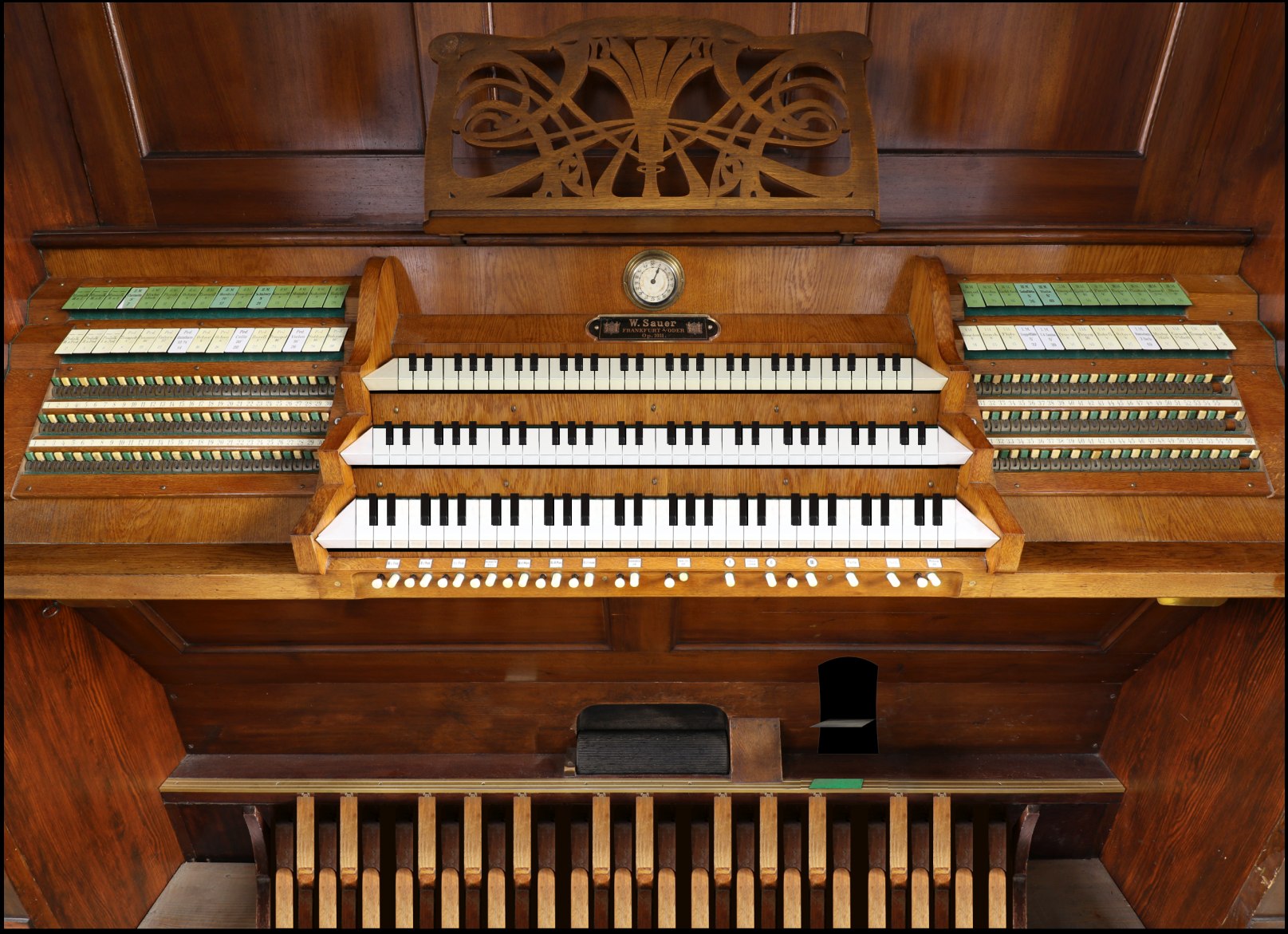
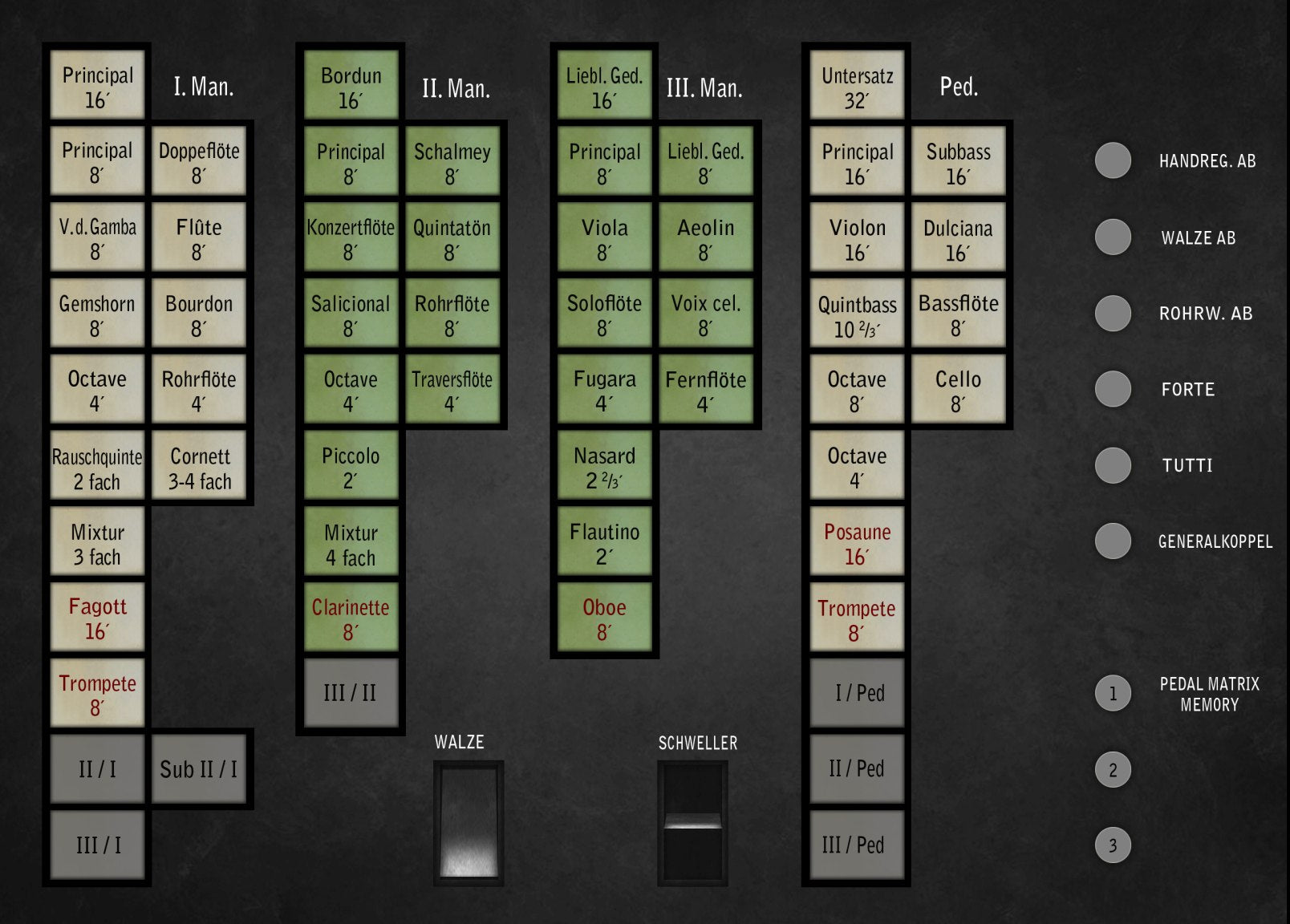
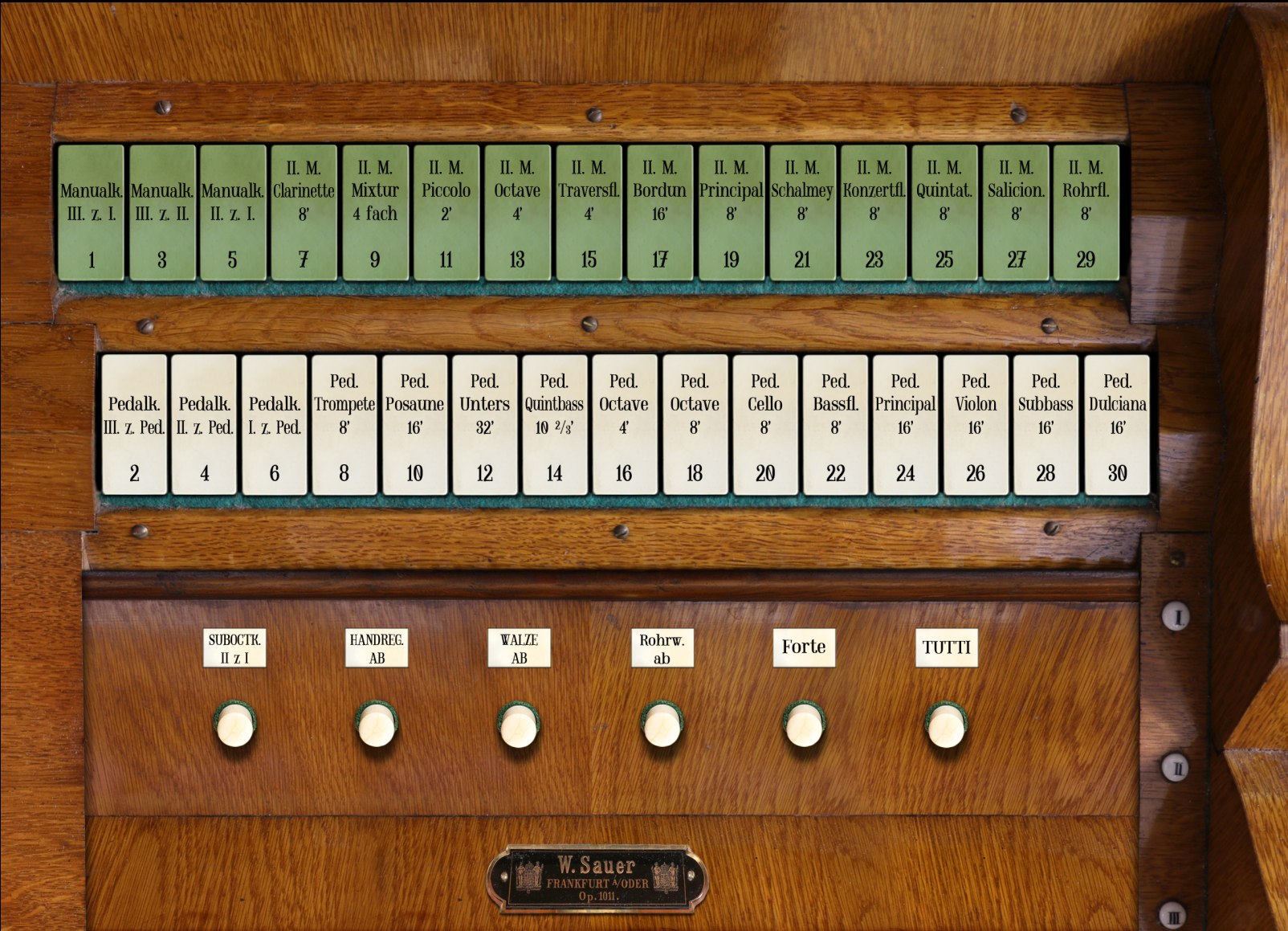

Requirements
Hauptwerk v.4.2 and higher supported. The sample set is offered in a plain wave format, no encryption.
RAM consumption: 8-channel surround
16-bit, other settings default: 22.9 GB
20-bit, other settings default: 41 GB
24-bit, other settings default: 43.7 GB
RAM consumption: 2-channel wet (distant channels solo)
16-bit, other settings default: 6.5 GB
20-bit, other settings default: 11.1 GB
24-bit, other settings default: 12 GB
Screen resolution 1280x1024 px or more.
Polyphony of 5500 voices recommended for the full suround (3000 pipes minimum).
This Hauptwerk Sample Set is presented to you by Leonart Studio, an authorised reseller for the manufacturer Sonus Paradisi in Switzerland (shipping internationally). Enjoy this digitally sampled organ library for the use with Hauptwerk software and start expanding your historical organ collection today.
More Hauptwerk Sample Sets
-
Casavant, 1995 [Hauptwerk]
Fornecedor:Sonus ParadisiPreço normal CHF 174.90Preço normalPreço unitário / por -
Reuter, 1928 [Hauptwerk]
Fornecedor:Sonus ParadisiPreço normal CHF 473.00Preço normalPreço unitário / por -
![Rotterdam Hoofdorgel, 1973 [Hauptwerk]](//artful.shop/cdn/shop/files/ss_RotterdamMain1.jpg?v=1693279529&width=533) Em promoção
Em promoçãoRotterdam Hoofdorgel, 1973 [Hauptwerk]
Fornecedor:Sonus ParadisiPreço normal A partir de CHF 330.00Preço normalPreço unitário / porCHF 958.10Preço de saldo A partir de CHF 330.00Em promoção -
![Groningen, 1450-1740 [Hauptwerk]](//artful.shop/cdn/shop/files/ss_Groningen1.jpg?v=1693275425&width=533) Em promoção
Em promoçãoGroningen, 1450-1740 [Hauptwerk]
Fornecedor:Sonus ParadisiPreço normal A partir de CHF 658.90Preço normalPreço unitário / porCHF 1,681.90Preço de saldo A partir de CHF 658.90Em promoção -
Goerlitz, 2006 [Hauptwerk]
Fornecedor:Sonus ParadisiPreço normal A partir de CHF 328.90Preço normalPreço unitário / por -
Bückeburg, 1997 [Hauptwerk]
Fornecedor:Sonus ParadisiPreço normal A partir de CHF 1.10Preço normalPreço unitário / por -
Brasov, 1839 [Hauptwerk]
Fornecedor:Sonus ParadisiPreço normal CHF 418.00Preço normalPreço unitário / por -
![St. Omer, 1717-1855 [Hauptwerk]](//artful.shop/cdn/shop/files/ss_omer1.jpg?v=1692904128&width=533) Em promoção
Em promoçãoSt. Omer, 1717-1855 [Hauptwerk]
Fornecedor:Sonus ParadisiPreço normal CHF 323.40Preço normalPreço unitário / porCHF 410.96Preço de saldo CHF 323.40Em promoção -
Stellwagen organ, St. Marien, Stralsund (1659)
Fornecedor:Sonus ParadisiPreço normal CHF 858.00Preço normalPreço unitário / por -
![Clavichord Model [Hauptwerk]](//artful.shop/cdn/shop/files/ss_clavichord.jpg?v=1724310155&width=533) Esgotado
EsgotadoClavichord Model [Hauptwerk]
Fornecedor:Sonus ParadisiPreço normal CHF 33.00Preço normalPreço unitário / por


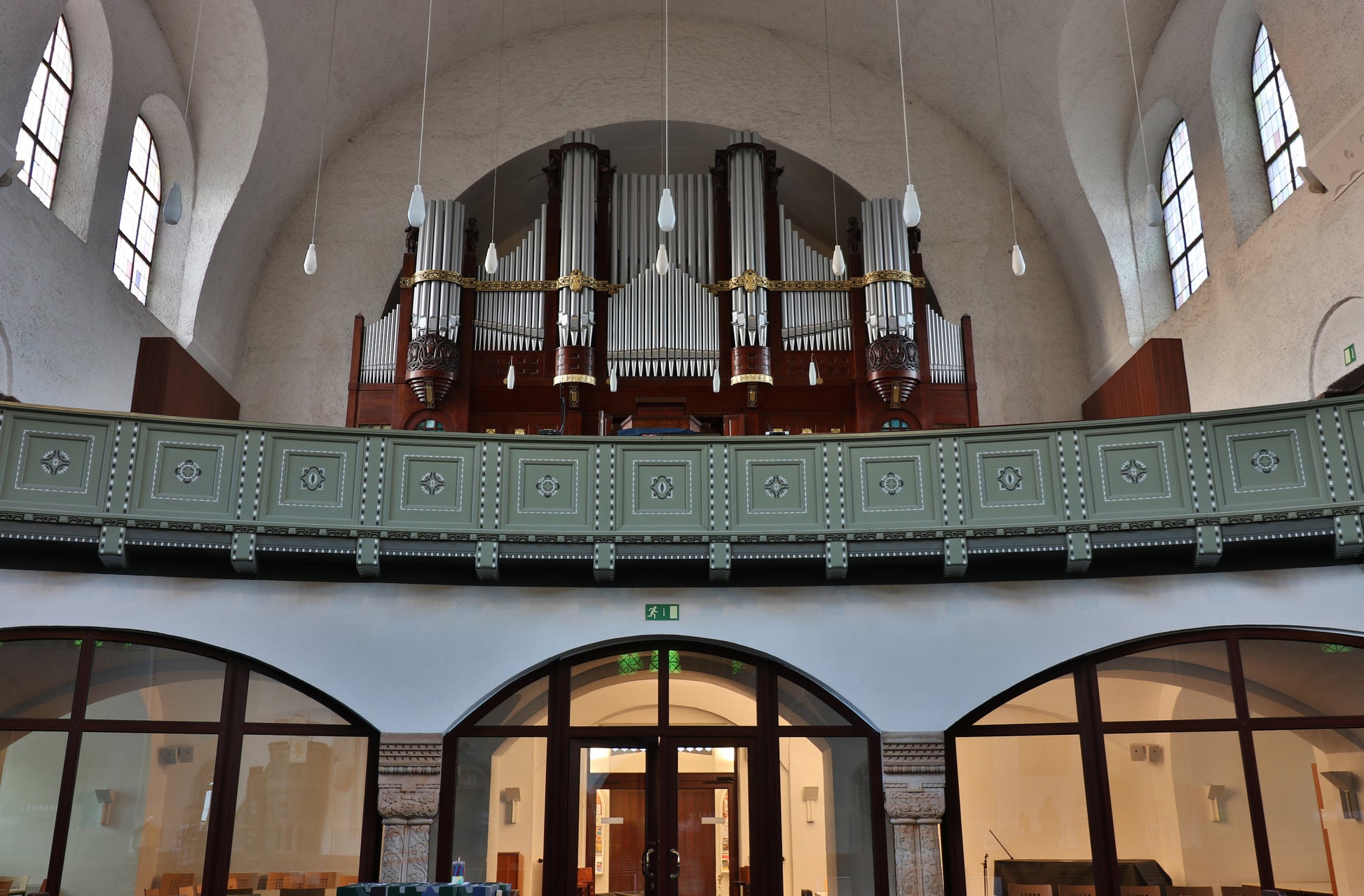
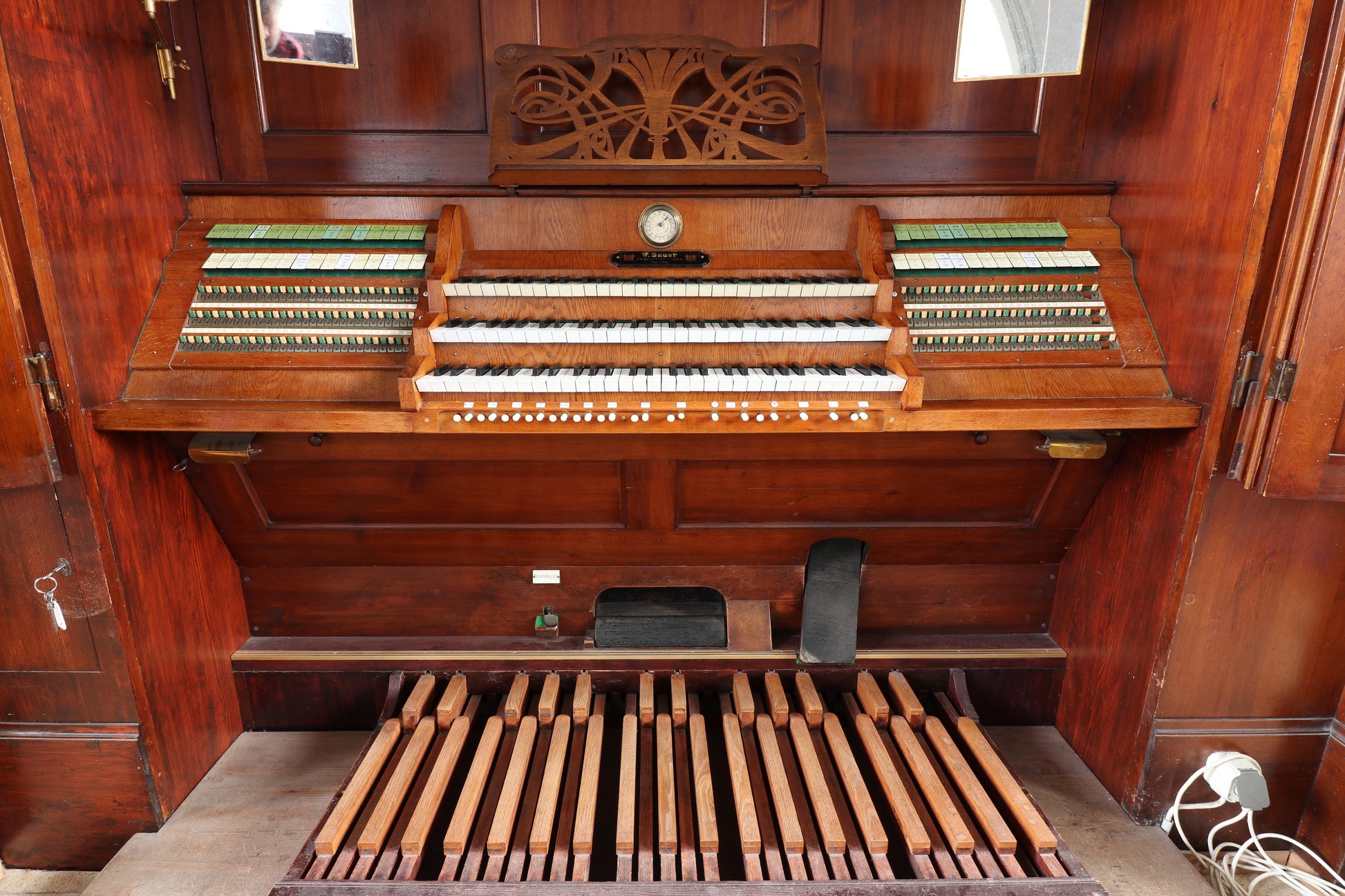
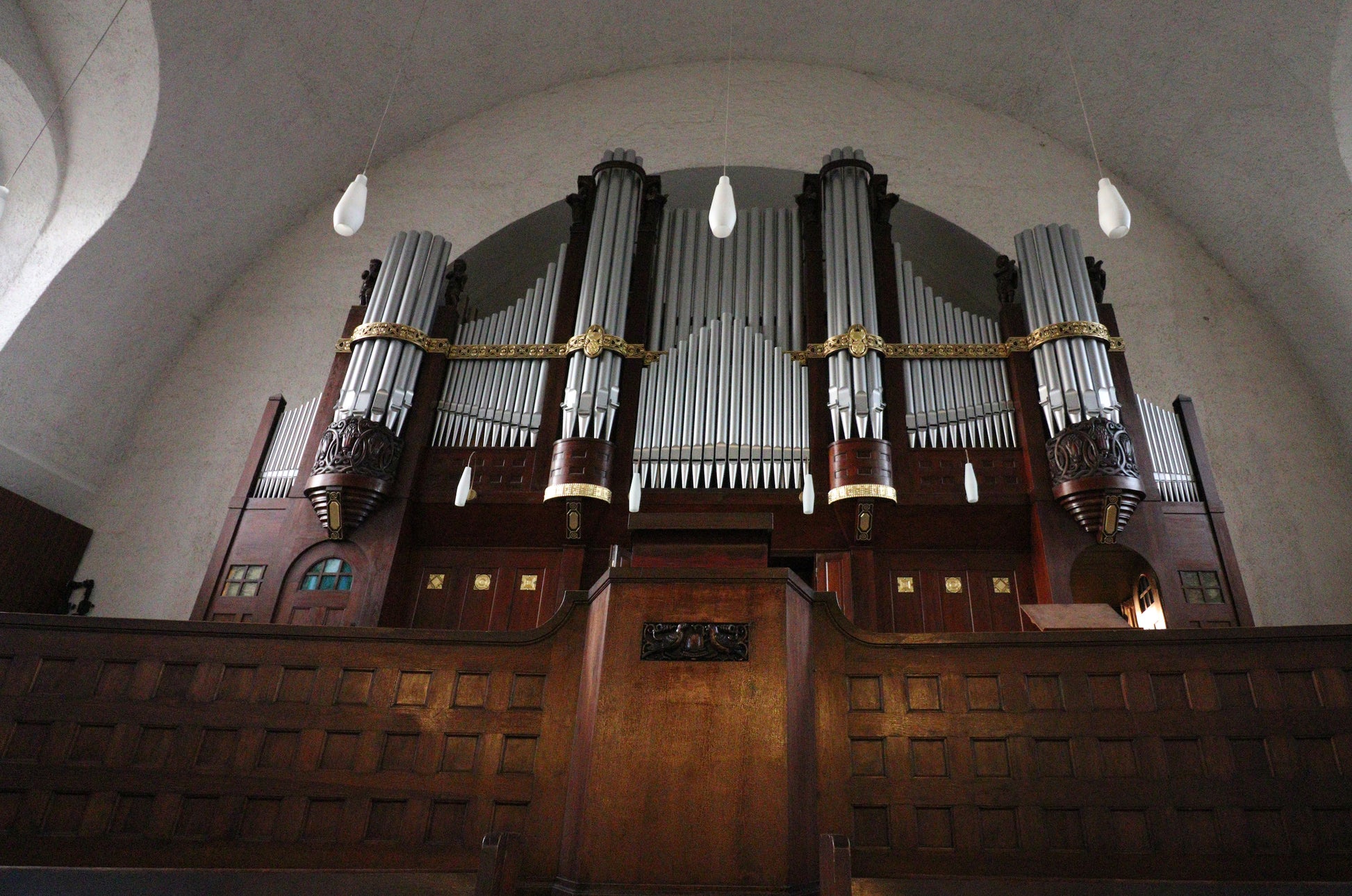

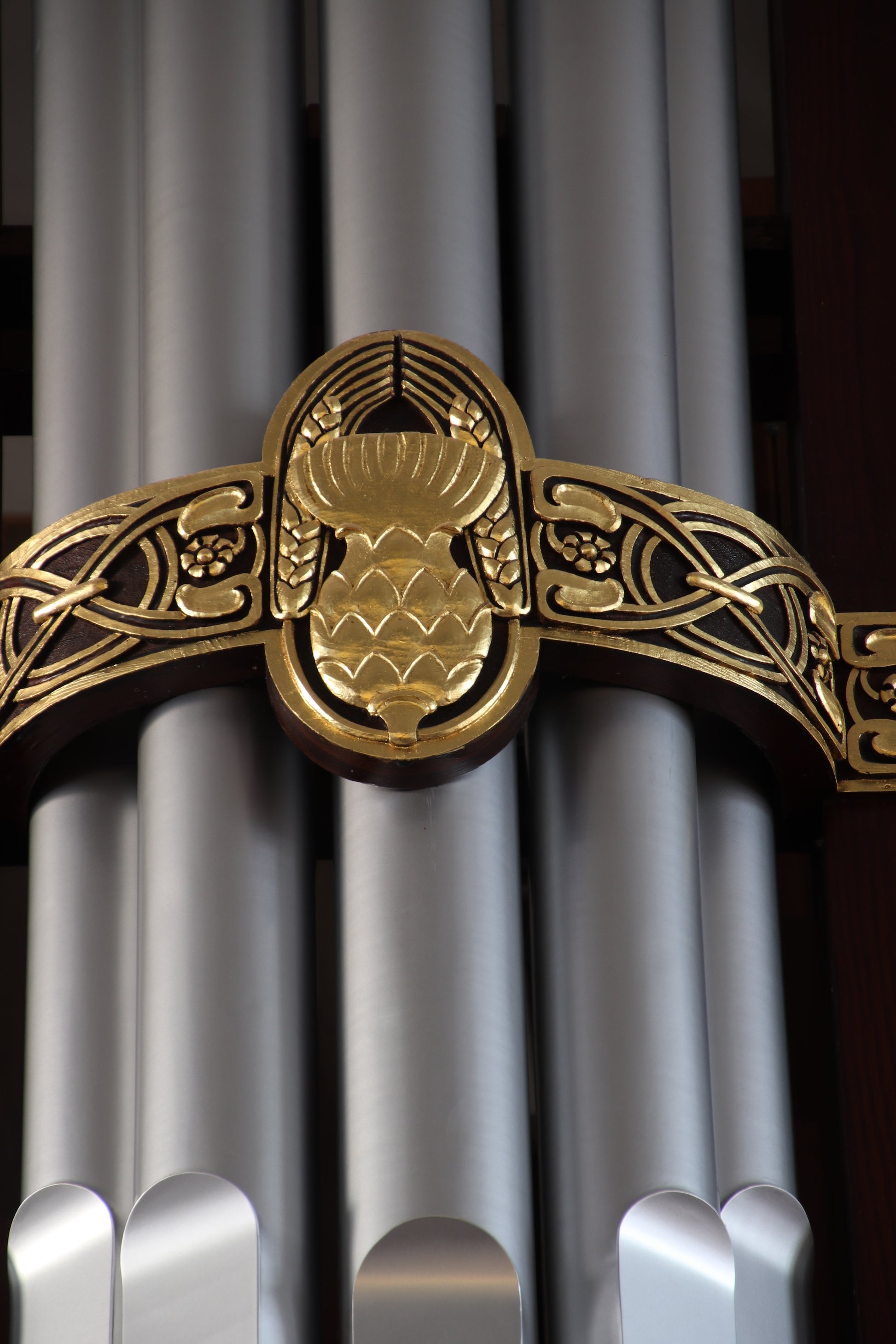

![Casavant, 1995 [Hauptwerk]](http://artful.shop/cdn/shop/files/ss_casavant1.jpg?v=1693319885&width=533)
![Reuter, 1928 [Hauptwerk]](http://artful.shop/cdn/shop/files/ss_Reuter1.jpg?v=1693321024&width=533)
![Rotterdam Hoofdorgel, 1973 [Hauptwerk]](http://artful.shop/cdn/shop/files/ss_RotterdamMain1.jpg?v=1693279529&width=533)
![Groningen, 1450-1740 [Hauptwerk]](http://artful.shop/cdn/shop/files/ss_Groningen1.jpg?v=1693275425&width=533)
![Goerlitz, 2006 [Hauptwerk]](http://artful.shop/cdn/shop/files/ss_goerlitz1.jpg?v=1692995837&width=533)
![Bückeburg, 1997 [Hauptwerk]](http://artful.shop/cdn/shop/files/ss_bueckeburg1.jpg?v=1692967628&width=533)
![Brasov, 1839 [Hauptwerk]](http://artful.shop/cdn/shop/files/ss_brasov1.jpg?v=1692967057&width=533)
![St. Omer, 1717-1855 [Hauptwerk]](http://artful.shop/cdn/shop/files/ss_omer1.jpg?v=1692904128&width=533)
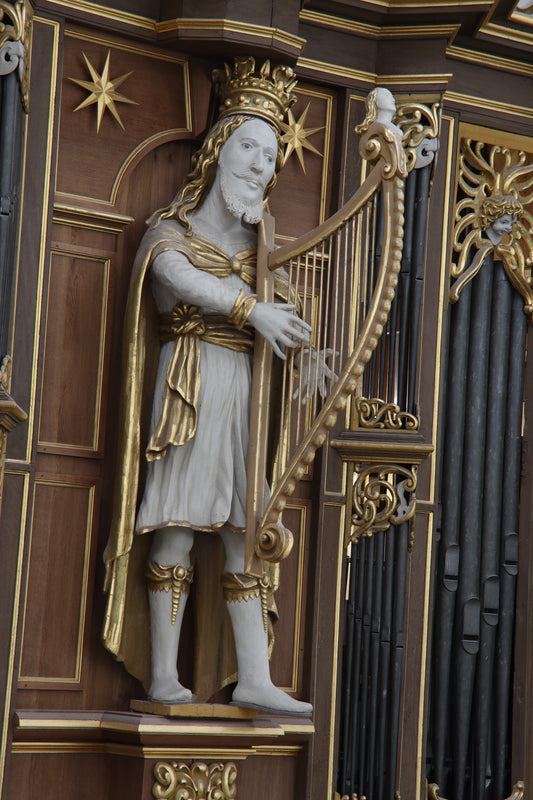
![Clavichord Model [Hauptwerk]](http://artful.shop/cdn/shop/files/ss_clavichord.jpg?v=1724310155&width=533)